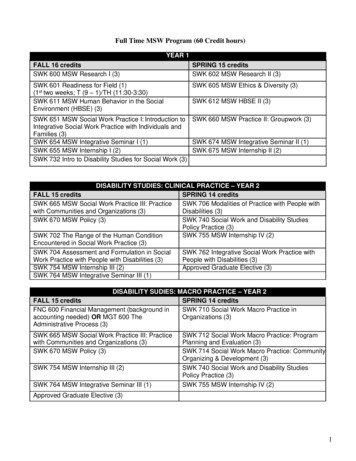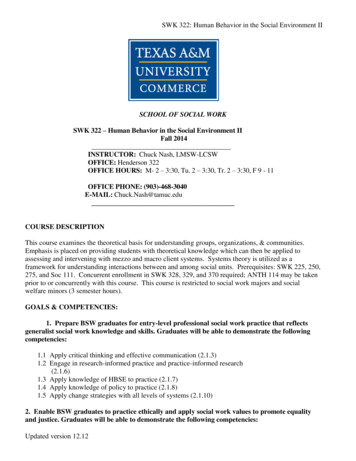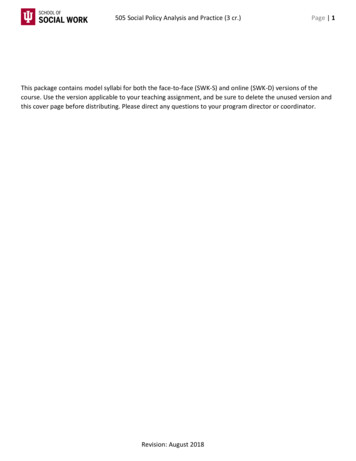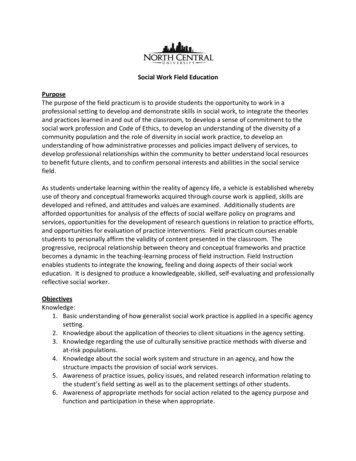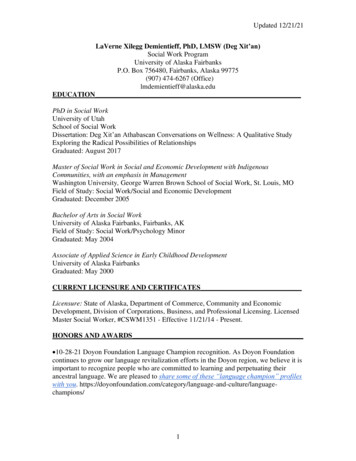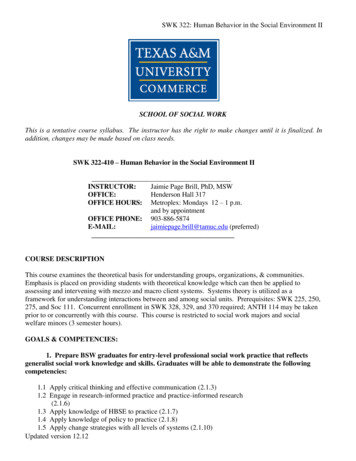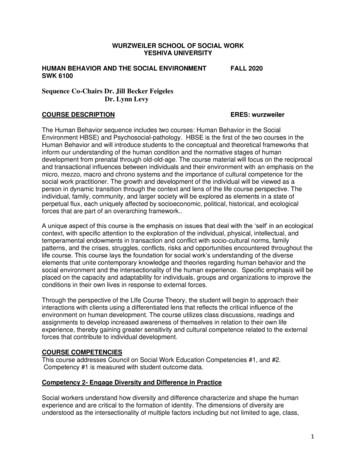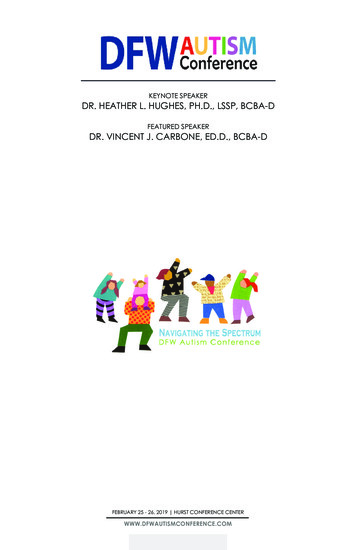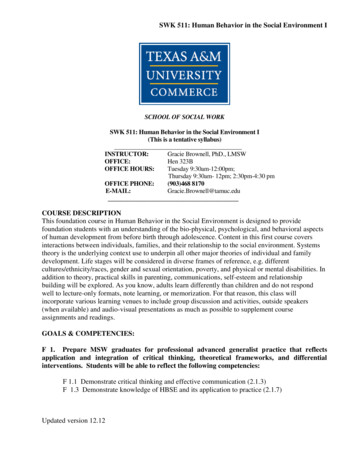
Transcription
SWK 511: Human Behavior in the Social Environment ISCHOOL OF SOCIAL WORKSWK 511: Human Behavior in the Social Environment I(This is a tentative syllabus)INSTRUCTOR:Gracie Brownell, PhD., LMSWOFFICE:Hen 323BOFFICE HOURS:Tuesday 9:30am-12:00pm;Thursday 9:30am- 12pm; 2:30pm-4:30 pmOFFICE PHONE:(903)468 8170E-MAIL:Gracie.Brownell@tamuc.eduCOURSE DESCRIPTIONThis foundation course in Human Behavior in the Social Environment is designed to providefoundation students with an understanding of the bio-physical, psychological, and behavioral aspectsof human development from before birth through adolescence. Content in this first course coversinteractions between individuals, families, and their relationship to the social environment. Systemstheory is the underlying context use to underpin all other major theories of individual and familydevelopment. Life stages will be considered in diverse frames of reference, e.g. differentcultures/ethnicity/races, gender and sexual orientation, poverty, and physical or mental disabilities. Inaddition to theory, practical skills in parenting, communications, self-esteem and relationshipbuilding will be explored. As you know, adults learn differently than children and do not respondwell to lecture-only formats, note learning, or memorization. For that reason, this class willincorporate various learning venues to include group discussion and activities, outside speakers(when available) and audio-visual presentations as much as possible to supplement courseassignments and readings.GOALS & COMPETENCIES:F 1. Prepare MSW graduates for professional advanced generalist practice that reflectsapplication and integration of critical thinking, theoretical frameworks, and differentialinterventions. Students will be able to reflect the following competencies:F 1.1 Demonstrate critical thinking and effective communication (2.1.3)F 1.3 Demonstrate knowledge of HBSE and its application to practice (2.1.7)Updated version 12.12
SWK 511: Human Behavior in the Social Environment IF 2. Enable MSW graduates to apply ethical reasoning to advance equality, justice, and socialchange. Students will be able to reflect the following competencies:F 2.2 Apply social work ethics & principles (2.1.2)F 2.3 Engage diversity in practice (2.1.4)F 2.4 Promote human rights and social and economic justice (2.1.5)F 3. Promote leadership and service that is relevant to individual contexts of practice andenhances well-being and quality of life. Students will be able to reflect the followingcompetencies:F 3.1 Engage as professional social workers (2.1.1)COURSE OBJECTIVES:This course is designed to provide first semester foundation students with an understanding of thebiophysical, psychological and social systems aspects of human development. Content in this coursein human behavior covers interactions between individuals and their environments and betweenfamilies and their environments. It covers the lifespan from conception through adolescence. Systemstheory is the underlying context used to underpin all other major theories of individual and familydevelopment. In addition, the course addresses issues of diversity including ethnocentrism, racismand physical/intellectual ability.STUDENT LEARNING OUTCOMES:1. Students will demonstrate in writing and through class participation the formulation of anecological frame of reference for describing human behavior which is based on foundation ofsystems theory.2. Students will demonstrate through objective evaluation (exams) basic knowledge of theecological factors stemming from biological, psychological, and sociological origins that affectthe functioning of individuals, families, groups, organization and communities;3. Students will demonstrate through objective evaluation and class participation the ability tosynthesize information regarding specific human diversity factors (i.e. memberships in racial andethnic groups, gender issues, and sexual orientation) which have influence from infancy throughadolescence and can affect an individuals’ ability to cope with difficulties or changes in his/herenvironment.4. Students will demonstrate through class participation, written assignments and objectiveevaluation an understanding of the relationship between individual growth and development andthe larger systems in which it occurs, particularly families, groups, neighborhoods andcommunities.5. Students will explain multi-determinants of social functioning including biological,psychological, spiritual, and socio-cultural factors that contribute to the make-up of the wholeperson.RELATIONSHIP TO OTHER COURSES:This course is an integral part of the foundation sequence in the program. It is the first exposure tosystems theory, which is essential to an understanding of the generalist and advanced generalistUpdated version 12.12
SWK 511: Human Behavior in the Social Environment Icourses, as well as field practicum courses.PRACETICE BEHAVIORSCompetency BenchmarkCompetency2.1.7Apply knowledge of humanbehavior and the socialenvironmentPractice Behavior7.1 Is knowledgeable about human behavioracross the life course7.2 Is knowledgeable about the range ofsocial systems in which people live7.3 Is knowledgeable about the ways socialsystems promote or deter people inmaintaining or achieving health and wellbeing7.4 Is skilled at applying theories andknowledge about biological variables,social variables, cultural variables,psychological variables, and spiritualdevelopment7.5 Is skilled at utilizing conceptualframeworks to guide the processes ofassessment, intervention, and evaluationTEXTS :Zastrow, C.H. & Kirst-Ashman, K.K. (2007). Understanding human behavior and the socialenvironment. 9th ed. Belmont CA: Brooks/Cole-Thomas Learning.Additional articles and handouts will be given throughout the semester to enhance the students’knowledge base.GRADING :Grading will be done on a contractual, graduated grading scale. Each student will have theopportunity to map out his/her destination by opting for a tract leading to an A or B. The student is tonotify the instructor by the third class week of his/her decision.ABParticipation ActivitiesParticipation ActivitiesSelf-Reflection PaperMid-Term ExamMid-Term ExamFinal ExamFinal ExamArticle ReviewArticle ReviewResearch PaperSelf-Reflection PaperTotal Possible PointsTotal Possible Points550450550 to 495 A450 to 405 B494 to 440 B404 to 360 C439 to 385 CUpdated version 12.12
SWK 511: Human Behavior in the Social Environment IEXAMINATIONS:All students are expected to take two examinations: a midterm and final examination. Exam dates arenoted on the syllabus Course Outline. The midterm will cover the information from readings, lecturesand class discussion prior to the test date. The Final exam will cover the materials in the second halfof the course. Each exam is worth 100 points.OVERVIEW OF ASSIGNMENTS:CLASS PARTICIPATION (50 points)Over the course of the semester there will be five class activities or opportunities for participation.Each activity will be worth 10 points. A student will receive full credit for active participation andcontributing to the subject. (these are essentially free points simply for being involved in class).REACTION PAPER 1: SELF REFLECTION PAPER (100 points)Reflect upon your life including your experiences from birth through adolescence and your reasonsfor becoming a social worker. This is not a full self-revelation of all of your life experiences, but lookat key factors that led you to this career.Using the introductory course materials we have read so far (chapter 1), what influenced your lifecourse? Identify, define and apply 4 theories/perspectives and 8 concepts that can help you furtherunderstand your previous life stages that brought you to where you are now. Underline the appliedconcepts and theories.Explore the concerns/issues you faced as a teenager. Incorporate, as appropriate, any possible impacton culture, ethnicity, race, sexual orientation, physical/cognitive/developmental factors, socioeconomic status, spirituality or other aspects of the human condition which impact your worldview.Paper should be 2-3 pages in length. Minimum of 3 peer reviewed journal references. The firstreaction paper should be written in first person.REACTION PAPER 2 (beginning of Research Paper): 501. You need to pick a subject significantly different from yourself. Interview and write a case study ofa life event on a child or adolescent during one of Erikson’s, stages of development (referred to as the“subject” or you may make up a fake name with parenthesis around the name for the first use).(20pts).2. Examine the NASW Code of Ethics that relate to human diversity with regard to the worth anddignity of all persons. (20pts)3. Please describe in a paragraph your experience interviewing your subject and examining the codeof ethics as it related to him/her. (10pts)4 Format: Third Person. No need for a cover page and 1-2 pages, double-spaced 12-point font –Graded on spelling, grammar and completion and clarity of each section (# 1, 2 & 3) You papershould be organized and should have three distinct sections as instructed in number 1-3. For exampleyou sections could be titled: Case study, NASW Code of Ethics, human diversity and dignity of all,and How I applied the Code of ethics during my interviewUpdated version 12.12
SWK 511: Human Behavior in the Social Environment IARTICLE REVIEW (50 points)Find an article in a professional journal about an aspect of childhood or adolescence and/or apsychological theory of development related to your upcoming case study and upcoming researchpaper. Write a review of the article. The paper should be approximately 2-3 pages in length andtyped, double-spaced. The paper should include three separate sections: reference, summary, andcritique. The reference should be at the top of the first page and should be in APA style A concise summary of the major points, statements, or facts of the article The critique should contain how this article relates to your case study and research paper,class readings and discussions and your personal opinion about the article. Include what you thinkabout the author’s position and how the article fits in with your personal beliefs. What futureresearch regarding this topic needs to be done or would be helpful.Research Paper (100 points):A 10-15 page paper to be written utilizing an ecological perspective for analyzing the potential effectof a life event on a child or adolescent during one of Erikson’s, stages of development. Referencesrequired are 8-10 peer reviewed journal articles, you can use no more than 2 electronic references.The purpose of this paper is to add to the student’s understanding of how Erikson theory andecological perspective applies to an in-depth analysis of a client. Also it is intended to add to thestudents’ knowledge in assessing the impact of the micro, mezzo and macro levels on clientfunctioning or potential functioning. The text should be focused on the following issues:Characteristics of the client (e.g. memberships in a racial group, ethnicity, gender age etc).Describe a major event in a client’s life.Select and identify the issues of the stage when the major event occurred.What will happen if this stage is traumatized? Describe the consequence of pathology for thatstage in general terms, and secondly, illustrate how you subject will demonstrate this pathology.How will the trauma event ripple through subsequent stages? While this is speculation, use thesubsequent conflicts as described by Erikson to defend your speculation. Also, discuss therelationship of this event and its potential to produce social and economic oppression as well asother continuing risk factors for the individual.Finally, discuss any specific cultural issues and how these may have impacted the client.ExamplesA five year old African-American child looses a parent in an automobile crashA thirteen year old witnesses a school shooting at his/her middle school**** If you would like to do a research paper utilizing a different approach or subject, review withthe instructor. Once you have chosen your topic inform the instructor of your subject.Updated version 12.12
SWK 511: Human Behavior in the Social Environment IGUIDELINES FOR ALL WRITTEN WORKWritten work for this class must be in APA style using 12-point font. Grading criteria for written workincludes: thoroughness, logical development of points, clarity of written expression, application ofscholarly research and appropriateness of information presented as it relates to topic chosen (SeeRubrics for Grading Expectations). This is a graduate level course andexpectations are considerably higher than those at an undergraduate level. It is important todemonstrate your ability to do research at the library, to critically analyze various positions,comparing and contrasting strengths and weaknesses, and presenting facts in a manner persuading thereader to his/her own conclusions. Citations from course texts, the internet (unless accessing an online journal or government document), popular magazines or handouts given by the instructor do notrepresent scholarly research and should be used sparingly.CLASS ATTENDANCE AND PARTICIPATION:Students are expected to attend class, reflecting responsibility which is inherent in the development asa social work professional. Roll will be taken regularly. Students are expected to be on time andprepared to participate when class begins as well as be present throughout the entire class meeting.Classroom exercises, discussions, role plays, guest speakers and other in-class experiential exercisesare essential for a student’s professional learning and continued development of self-awareness.Tardiness (or early departure) of more than 15 minutes will count as .5 absence (2 tardies/earlydepartures 1 absence). A student is considered absent if he/she arrives more than 30 minutes late toclass, leaves 30 or more minutes early or does not come to class.The following penalties for absences (unexcused, or excused, according to university policy) will beadministered:WeeklyBi-weeklySummer10-weekUp to 2absences NopenaltyUp to 3 absencesNo penaltyUp to 1 absenceNo penalty3 absences1 letter gradedrop4 absences1 letter grade drop2 absences1 letter grade drop4 absencesClass grade of “F”5 absences1 letter grade drop3 absencesClass grade of “F”6 absencesClass grade of “F”ONLINE OR WEB-ENHANCED CLASSES: Just as students are required to attend face-to-faceclasses, students are required to log in and participate in online components. To receive credit forattendance online via eCollege, students must log in and complete assignments in a timely manner.Not logging in to eCollege (which can be monitored by the instructor) and completing assignmentsonline during the appropriate time is the equivalent of an absence for each week this occurs.Final evaluation and grades depend on both presence and participation. Students’ grades will besignificantly impacted by inadequate participation or lack of required time commitment each week.Students are expected to spend a comparable amount of time in the online learning environment asthey would in class (3 hours a week in the classroom). In addition, just as in traditional F2Fclassrooms, students are expected to spend time reading and studying class materials.Updated version 12.12
SWK 511: Human Behavior in the Social Environment INOTE: PROBLEMS WITH YOUR INTERNET CONNECTION AND/OR COMPUTER ARE NOTCONSIDERED AS REASONS FOR LACK OF PARTICIPATION. You have access to theuniversity’s computer labs (in the social work department AND other campus facilities, including thelibrary) as well as local libraries and other access to computers and ISPs.If you believe that you are unable to fulfill the requirements for the course you should talk with yourinstructor about the possibility of dropping or withdrawing.Class participation has three components: (1) Appropriate interactions with classmates,(2) Attentiveness, and (3) Active involvement in class activities. Evaluation of class participation isbased on instructor observation. Students will be given feedback if problems are evident.POLICY ON DUE DATES:Promptness in completing assigned tasks and readings is a requirement of this course.ASSIGNMENTS SUBMITTED AFTER THE BEGINNING OF THE CLASS PERIOD ONWHICH THEY ARE DUE WILL AUTOMATICALLY HAVE 5 POINTS DEDUCTED FROMTHE GRADE. AN ADDITIONAL POINT PER DAY WILL BE DEDUCTED FOR EACHDAY THEREAFTER. Assignments will NOT be accepted more than one week after the assigneddue date and a “0” will be given for the grade. If students do not turn in all required assignments,they will be ineligible for any grade higher than a “C”.POLICY ON PLAGIARISM AND CHEATING:Every student is expected to do his/her own work. Law, ethical standards, university policy, anddepartmental policy demand that students refrain from plagiarism and any form of cheating.Plagiarism is the "Act of appropriating the literacy composition of another, or parts of passages fromof his [or her] writings, or the ideas or language of the same, and passing them off as the products ofone's own mind." (Black's Law Dictionary, Abridged Fifth Edition, 1983). When using others'words, phrases, or ideas in writing, the original author should be given proper credit.Cheating may take different forms. These include, but are not limited to, copying others' answersduring an exam, using notes or other forms of help during an examination or quiz, except whenexplicitly permitted by the instructor, giving or receiving help on exams or assignments, orsubmitting work for one class which has already been submitted for another class for credit. Use ofcitations from the Internet without paraphrasing content AND proper referencing is regarded asplagiarism. Professors have the right to use electronic review programs (such as Turn It In”) toidentify plagiarism.The department does not tolerate plagiarism or cheating. A student found to be engaging in suchillegal and unethical conduct may receive a failing grade in the course and may be subjected tofurther disciplinary proceedings. Any assignment or exam that lacks honesty will be given a grade of"0".ACCEPTABLE CLASSROOM BEHAVIOR:Updated version 12.12
SWK 511: Human Behavior in the Social Environment I“Students at Texas A&M University-Commerce are expected to obey all federal, state, andlocal laws, in addition to the regulations of the University. The standards of Student Conductincluding disciplinary rules and procedures are designed to provide and conform to thebasic tenets of due process, as developed by institutions of higher education. As such, the Universitydistinguishes these procedures and regulations as an educational and growthprocess which is not intended to conform to adversary proceedings as in a court of law. (Student’sGuide Book, 2011, p. 35).CODE OF CONDUCT FOR SOCIAL WORK STUDENTSThe Department of Social Work expects all social work students to conduct themselves in an ethical,professional manner. Professional ethics are at the core of social work. The profession articulates itsbasic values, ethical principles, and ethical standards as set forth in the NASW Code of Ethics to guidesocial workers’ conduct. The Code is relevant to all social workers and social work students,regardless of their professional functions, the settings in which they work, or the populations theyserve. Accordingly, we expect social work students to demonstrate courtesy, respect and support forfellow students, instructors, clients, and all other persons.All students enrolled in BSW or MSW classes are expected to observe the tenets of the NASW Codeof Ethics and the Social Work Student Code of Conduct. Our Code of Conduct is reflective ofprofessional and academic expectations – a student who cannot demonstrate appropriate behaviorswill not be appropriate for practice in the social work profession. Students who violate these Codesmay be asked to meet with appropriate Social Work faculty (instructors or Program Directors). Inaddition, the department’s Academic and Professional Issues (API) Committee is responsible fordealing with student issues when requested by faculty.STUDENTS WITH DISABILITIESThe Americans with Disabilities Act (ADA) is a federal anti-discrimination statute that providescomprehensive civil rights protection for persons with disabilities. Among other things, thislegislation requires that all students with disabilities be guaranteed a learning environment thatprovides for reasonable accommodation of their disabilities. If you have a disability requiring anaccommodation, please contact:Office of Student Disability Resources and ServicesTexas A&M University-CommerceGee Library- Room 132Phone (903) 886-5150 or (903) 886-5835Fax (903) 468-8148StudentDisabilityServices@tamuc.eduUpdated version 12.12
SWK 511: Human Behavior in the Social Environment ICOURSE SCHEDULEWeekReading(s)1Review Syllabus, ClassIntroductions, /2910/05610/06-Assignment/ActivitiesLink to Comp.SLODue: REACTION PAPER 1: SELFREFLECTION PAPER (100 points)2.1.1, 2.1.2,2.1.3, 2.1.4,2.1.5, 2.1.6,2.1.7, 2.1.8,2.1.9, 2.1.101-52.1.1, 2.1.2,2.1.5, 2.1.7,2.1.101-5Chapter 1: Introduction toHuman Behavior and the SocialEnvironmentChapter 1: Introduction toHuman Behavior and the SocialEnvironmentDue in the Dropbox by 09/14 at11:59pmChapter 2: BiologicalDevelopment in Infancy &ChildhoodChapter 3: PsychologicalDevelopment in Infancy &Childhood**Identify Adolescent/Familyand potential questions forInterview2.1.1, 2.1.2,2.1.3, 2.1.4,2.1.7, 2.1.9,2.1.101-5Chapter 4: Social Developmentin Infancy & ChildhoodDue: REACTION PAPER 2(beginning of Research Paper)2.1.1, 2.1.2,2.1.3, 2.1.4,2.1.5, 2.1.6,2.1.7, 2.1.101-52.1.2, 2.1.4,1-5Due in the Dropbox by 09/29at 11:59pmContinuation/Review—Infancy& Childhood10/127Chapter 5: Ethnocentrism &Updated version 12.12
SWK 511: Human Behavior in the Social Environment Ethnocentrism & Racism9Chapter 6: BiologicalDevelopment in 711/231311/2411/30142.1.5, 2.1.7,2.1.10Mid-Term Exam2.1.1, 2.1.2, 2.1.3,2.1.5, 2.1.6, 2.1.7,2.1.8, 2.1.9 2.1.101-52.1.1, 2.1.2,2.1.3, 2.1.4,2.1.5, 2.1.6,2.1.7, 2.1.8,2.1.9, 2.1.101-5Chapter 8: Social Developmentin Adolescence2.1.2, 2.1.71-5Chapter 9: Gender, GenderIdentity, Gender Expression,and Sexism2.1.1, 2.1.2,2.1.3, 2.1.4,2.1.5, 2.1.7,2.1.8, 2.1.101-5ThanksgivingChapter 7: PsychologicalDevelopment in AdolescenceContinuation/Review—AdolescenceDue: ARTICLE REVIEW (50points)Research Paper DueWrap-up/Review12/0112/071512/0812/10Updated version 12.12Final Exam—Online
SWK 511: Human Behavior in the Social Environment IBIBLIOGRAPHY:REFERENCE MATERIALAmerican Psychological Association. (2002). Publication Manual of the AmericanPsychological Association. 5th.ed. Washington DC:Szuchman, L.T. and Thomlison, B. (2004). Writing with Style: APA style for SocialWork. 2nd.ed. Belmont CA: Brooks/ColePRINCIPLES AND THEORIES OF DEVELOPMENTBandura, A., & Walters, R. H. (1963). Social learning and personality development.New York: Holt, Rinehart and Winston.Bee, H., & Mitchell, S. (1980). The developing person: A life-span approach. NewYork: Harper and Row Publishers.Erikson, E. H. (1964). Childhood and society. New York: Norton.Freud, S. (1949). The basic writings of Sigmund Freud. New York: Norton.Gesell, A., & Amatrude, C. (1964). Developmental diagnosis. New York: Harper.Pavlov, I. P. (1927). Conditioned reflexes. London: Oxford University Press.Piaget, J. (1954). The construction of reality in the child. New York: Basic Books.Skinner, B. F. (1953). Science and human behavior. New York: Free Press.INFANT DEVELOPMENTBates, E. (1975). Language and context. New York: Academic Press.Biggs, J. L., & O'Connell, P.A. (1976). Teaching individuals with physical and multipledisabilities. Columbus, OH: Charles Merrill Publishing Co.Bronfenbrenner, U. (1975). Is early intervention effective? In B. Friedlander, G. Sterritt, G. Kirk (Eds.), Exceptional infant: Assessment and intervention (Vol. 3, pp. 449475). New York: Brunner/Mazel.Bromwich, R. (1981). Working with parents and infants, an interactional approach.Baltimore, MD: University Park Press.Chomsky, N. (1967). The formal nature of language. In E. Lenneberg (Ed.), Biologicalfoundations of language (pp. 397-443). New York: John Wiley & Sons.Denhoff, E. (1981). Current status of infant stimulation or enrichment programs forchildren with developmental disabilities. Pediatrics, 67, 32-37.Goldbert, G. S., & Lewis, M. (1969). Play behavior in the year old infant. ChildDevelopment, 401, 21-31.Gordon, I. J. (1971). A home learning center approach to early stimulation. Gainesville,FL: Institute for Development of Human Resources.Green, K. (1985). Seizures. Omaha, NE: Meyer Children's Rehabilitation Institute,University of Nebraska Medical Center.Piaget, J. (1954). The construction of reality in the child. New York: Basic Books.Piaget, J. (1962). Play, dreams and imitation in childhood. New York: W. W. Norton &Co.Skinner, B. F. (1957). Verbal behavior. New York: Appleton-CenturyCrofts.Wolfensberger, W. (1967). Counseling the parents of the retarded. In A. BaumeisterUpdated version 12.12
SWK 511: Human Behavior in the Social Environment I(Ed.), Mental retardation; appraisal, education and rehabilitation (pp. 329-378).Chicago: Aldine Publishing Company.EARLY CHILDHOOD YEARSAllen K. E. (1981). Curriculum models for successful mainstreaming. A. Mori (Ed.),Topics in Early Childhood Special Education, 45-56.Appolloni, T., & Cooke, T. P. (1978). Integrated programming of the infant, toddler andpreschool levels. In I.M. Guralnick (Ed.). Early intervention and the integration ofhandicapped and nonhandicapped children. Baltimore: University Park Press.Bandura, A., & Walters, R. (1963). Social learning and personality development. NewYork: Holt, Rinehart and Winston.Bloom, L., & Lahey, M. (1978). Language development and language disorders. NewYork: John Wiley & Sons.Bronfenbrenner, U. (1975). Is early intervention effective? In B. Friedlander, G. Sterritt, G. Kirk (Eds.), Exceptional infant: Assessment and intervention (Vol. 3). NewYork: Brunner/Mozel.Carey, S. (1977). The child as a word learner. In M. Halle, J. Bresnan, & G. Miller(Eds.). Linguistic theory and psychological reality. Cambridge, MA: MIT Press.deVilliers, P., & deVilliers, J. (1979). Early language. Washington, DC: HowardUniversity Press.Erikson, E. (1963). Childhood and society. New York: W. W. Norton.Guralnick, M. J., & Paul-Brown, D. (1980). Functional discourse analysis of nonhandicapped preschool children's speech to handicapped children. AmericanJournal of Mental Deficiency, 84, 444-454.Hartup, W. (1970). Peer interaction and social organization. In P.H. Mussen (Ed.),Carmichael's manual of child psychology (3rd ed., Vol. 2, pp. 361-456). New York:John Wiley & Sons.Kuhn, D., Nash, S., & Brucken, L. (1978). Sex role concepts of two and three year olds.Child Development, 49, 445-451.Laosa, L., & Brophy, J. (1972). Effects of sex and birth order on sex-role developmentand intelligence along kindergarten children. Developmental Psychology, , 409415.Linksz, A. (1973). On writing, reading and dyslexia. New York: Grune and Stratton.Piaget, J. (1959). The language and thought of the child. New York: The HumanitiesPress.Sander, E. (1972). When are speech sounds learned? Journal of Speech and HearingDisorders, 37, 62.Simeonsson, R., Cooper, D., & Scheiner, A. (1982). A review and analysis of theeffectiveness of early intervention programs. Pediatrics.MIDDLE CHILDHOOD YEARSBerger, K. (1980). The developing person. New York Worth Publishers, Inc.Block, J. H. (1976). Issues, problems, and pitfalls in assessing sex differences. MerrillPalmer Quarterly, 22, 283-308.Brown, A. L., & DeLoache, J. (1978). Skills, plans, and self-regulation. In R. SieglerUpdated version 12.12
SWK 511: Human Behavior in the Social Environment I(Ed.). Children's thinking: What develops (pp. 123-131). New York: Erlbaum.Cruickshank, W. (1977). Learning disabilities in home, school, and community .Syracuse, NY: Syracuse University Press.Elkind, D. (1971). sixteen. Boston. Allyn & Bacon, Inc.Erikson, E. (1963). Childhood and society (rev. ed.). New York: Norton.Garr, S. M. (1966). Body size and its implications. In L. W. Hoffman and M. L.Hoffman (Eds.), Review of child development research (Vol. 2, pp. 529-561). NewYork: Russell Sage Foundation.Gold, M. (1980). Did I say that: Articles and commentary on the Try Another Waysystem. Champaign, IL: Research Press Co.Hobbs, N. (Ed.). (1975). Issues in the classification of children (Vol 1). San Francisco:Jossey-Bass Publishers.Kagan, J., Rosman, B., Day, D., Albert, J., & Phillips, W. (1964). Informationprocessing in the child. Psvcholoqical Monographs. 78. 1-37.Kohlberg, L. (1969). Stages in the development of moral thought and action. New York:Holt, Rinehart and winston.Lerner, R., & Korn, S. (1972). The development of body build stereotypes in males.Child Development, 43, 908-920.Maccoby, E., & Jacklin, C. (1974). The psychology of sex differences. Palo Alto, CA:Stanford University Press.*Piaget, J. (1959). The language and thought of the child (3rd ed.). (Marjorie and RuthGabain, Trans.). London: Routledge and Kegan, Paul.Piaget, J. (1962). Play, dreams, and imitation in childhood. New York: W. W. Norton &Co.Piaget, J. (1963). The origin of intelligence in children. New York: W. W. Norton & Co.Whalen, C., & Henker, B. (1976). Psychostimulants and children: A review andanalysis. Psychological Bulletin, 83, 113-130.White, R. (1979). Competence as an aspect of personal growth. In M. Kent,& J. Rolf (Eds.), Primary prevention of psychopathology: Vol. III. Socialcompetence in children (pp. 76-84). Hanover, NH: University Press of NewEngland.ADOLESCENCEBrown, D., McDowell,
SWK 511: Human Behavior in the Social Environment I Updated version 12.12 F 2. Enable MSW graduates to apply ethical reasoning to advance equality, justice, and social change. Students will be able to reflect the following competencies: F 2.2 Apply social work ethics & principles (2.1.2) F 2.3 Engage diversity in practice (2.1.4)
